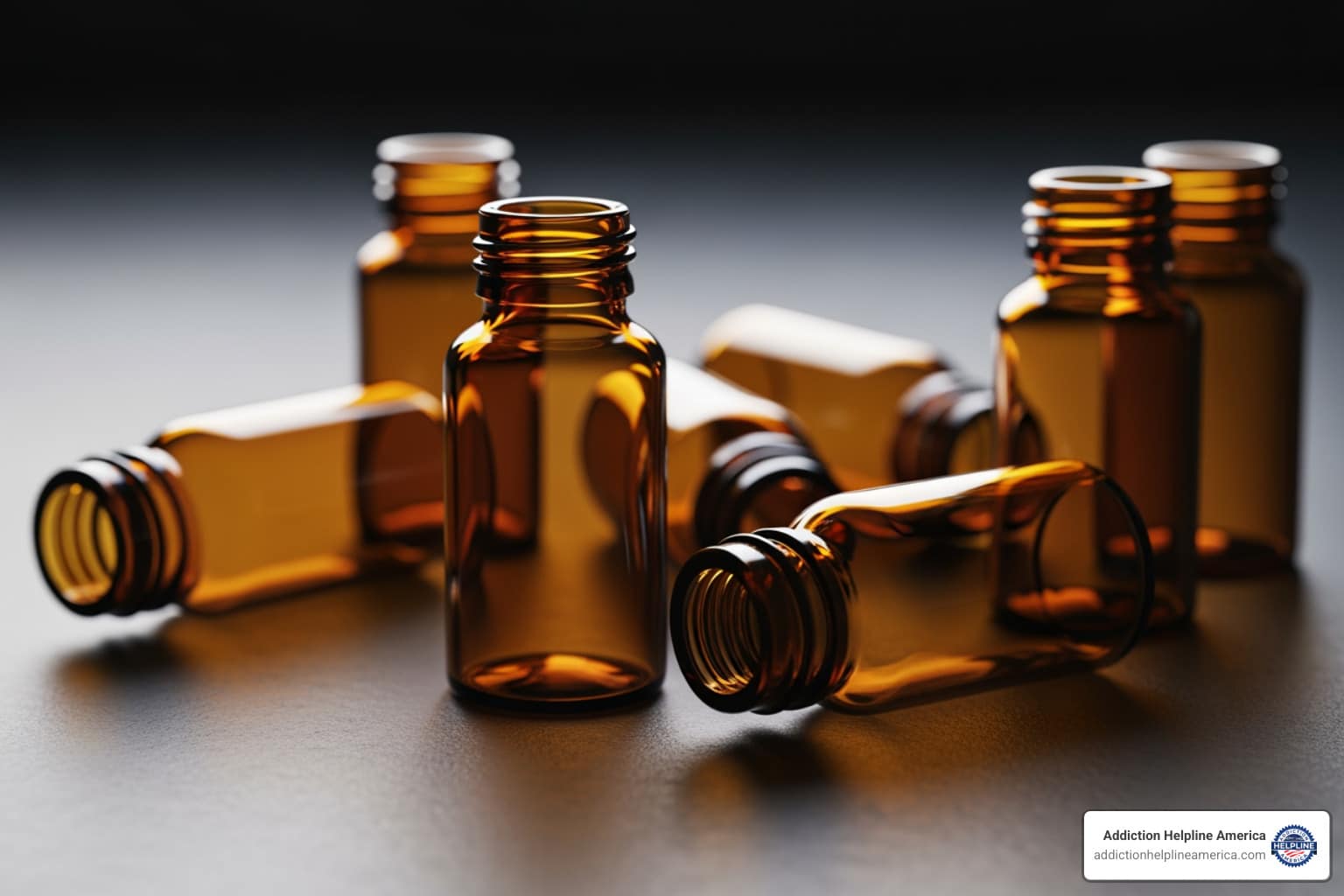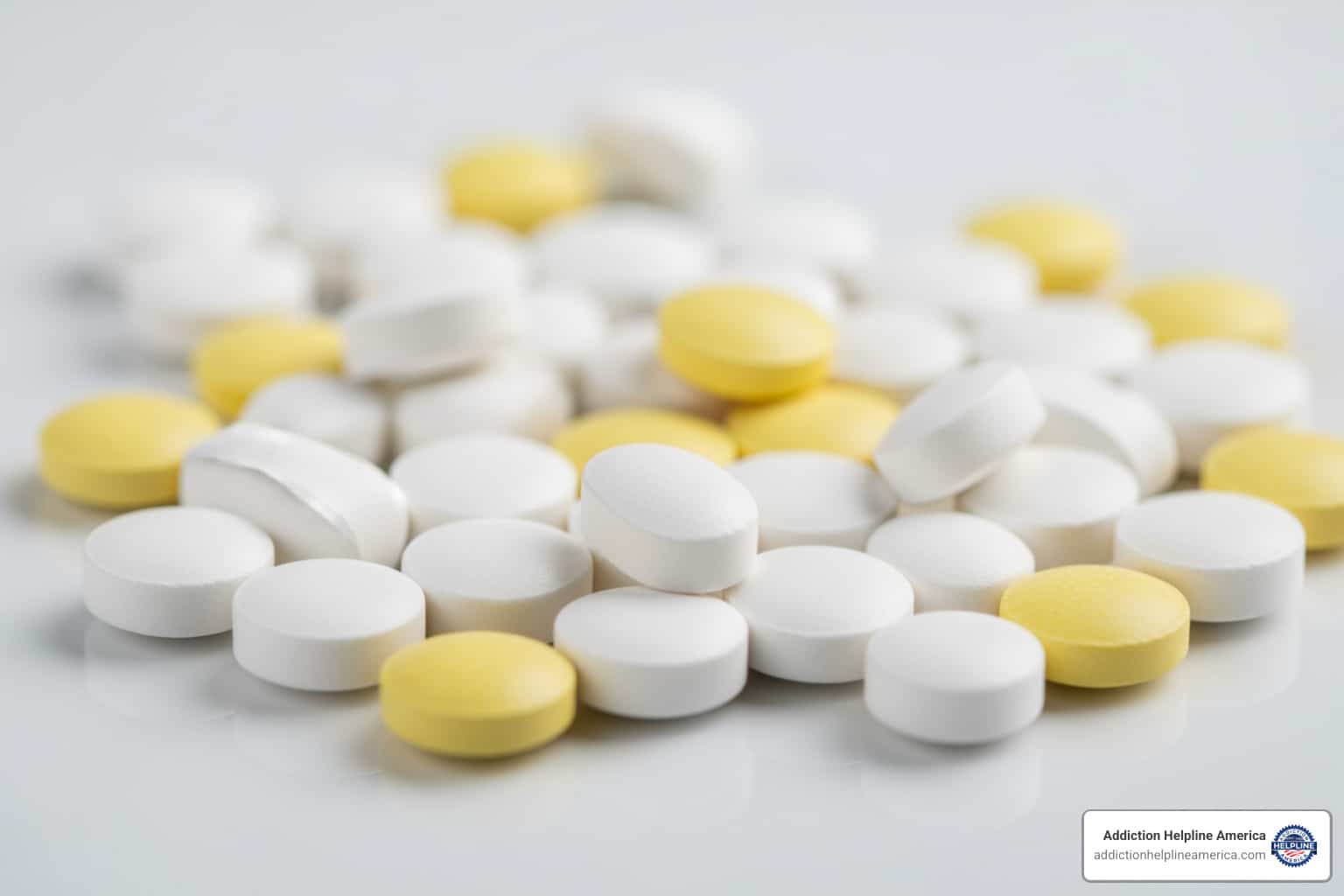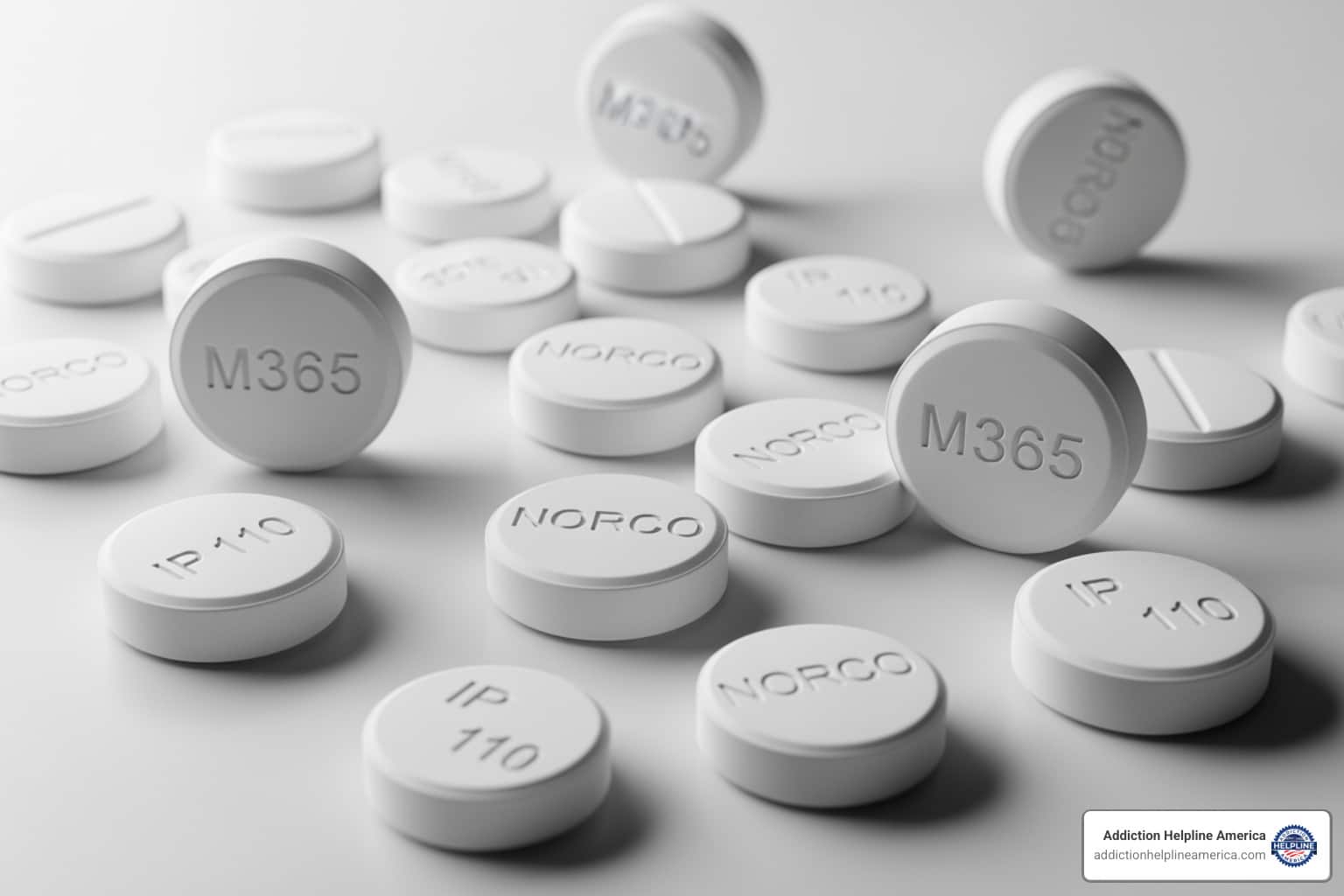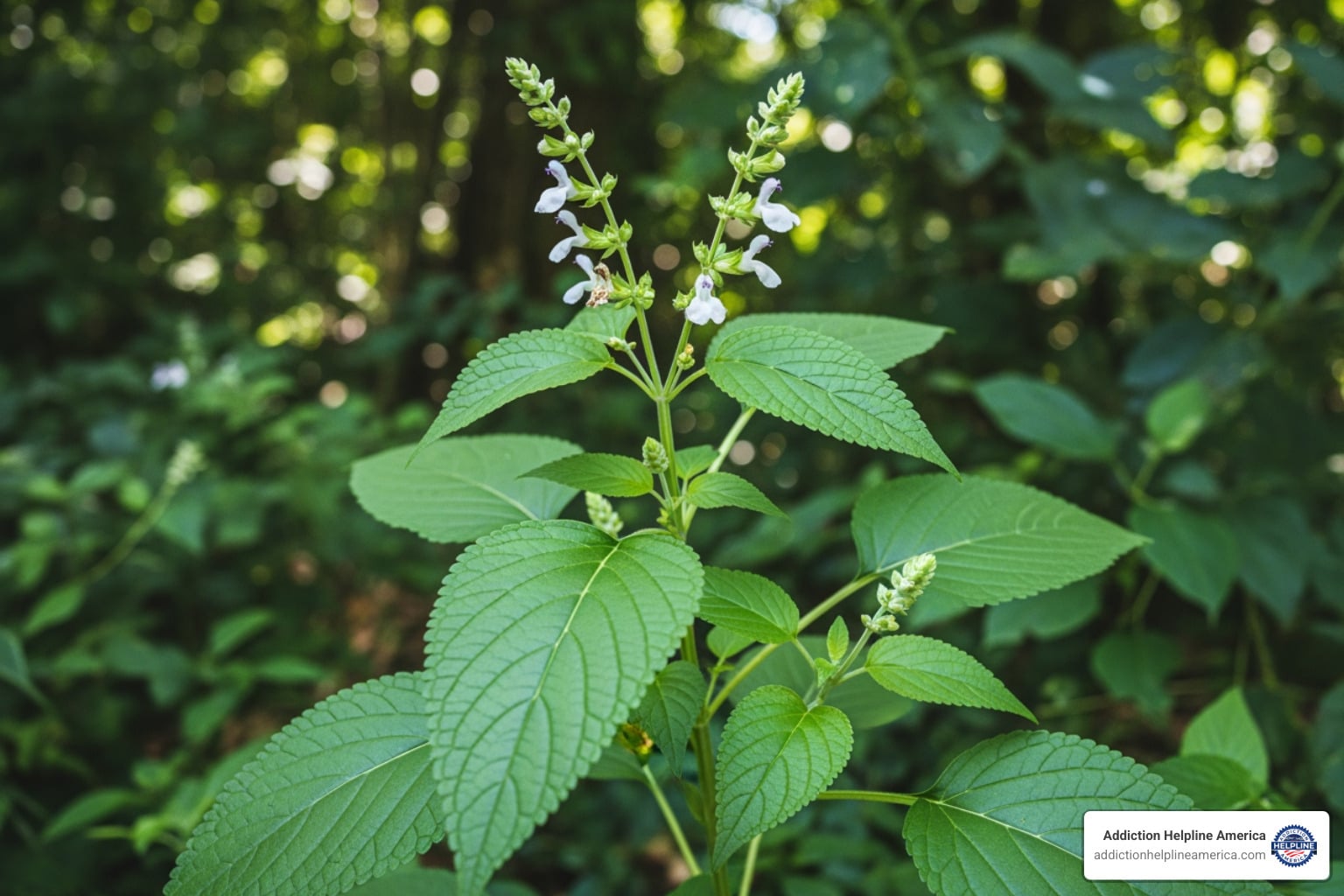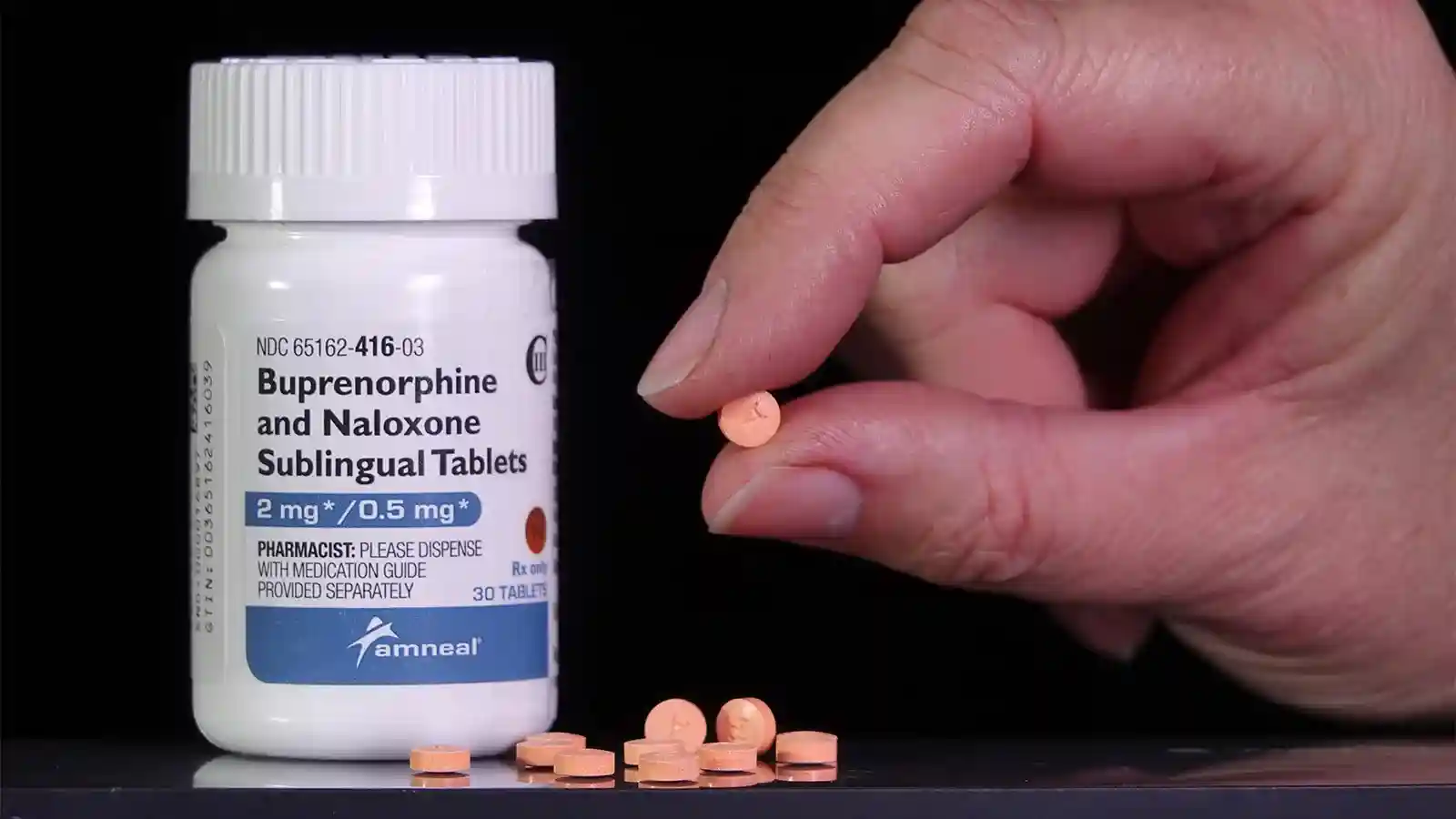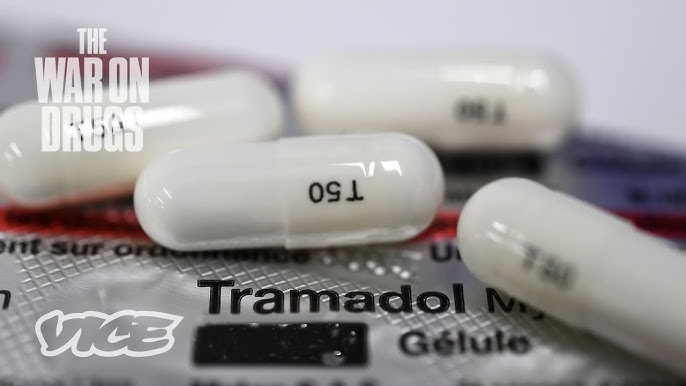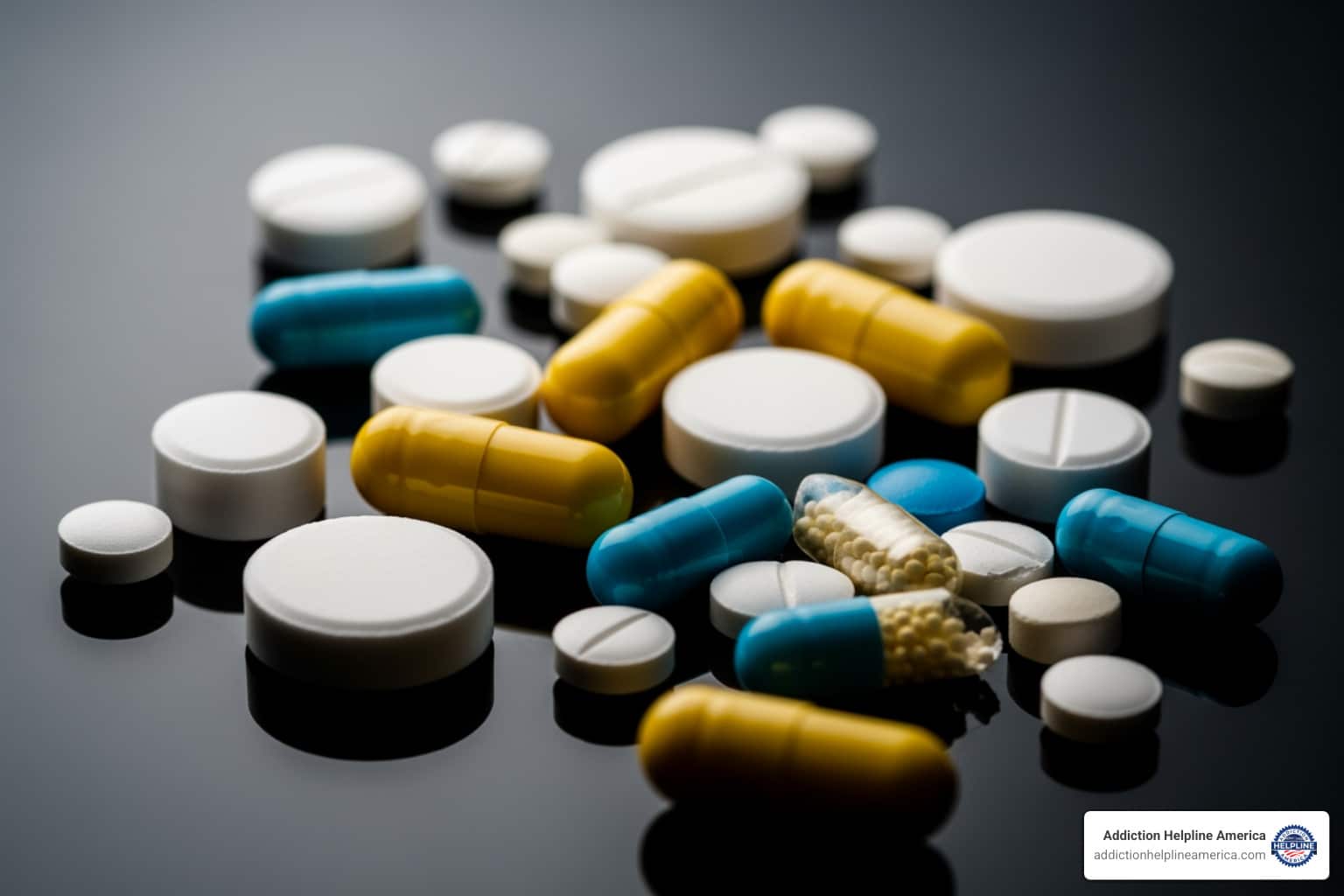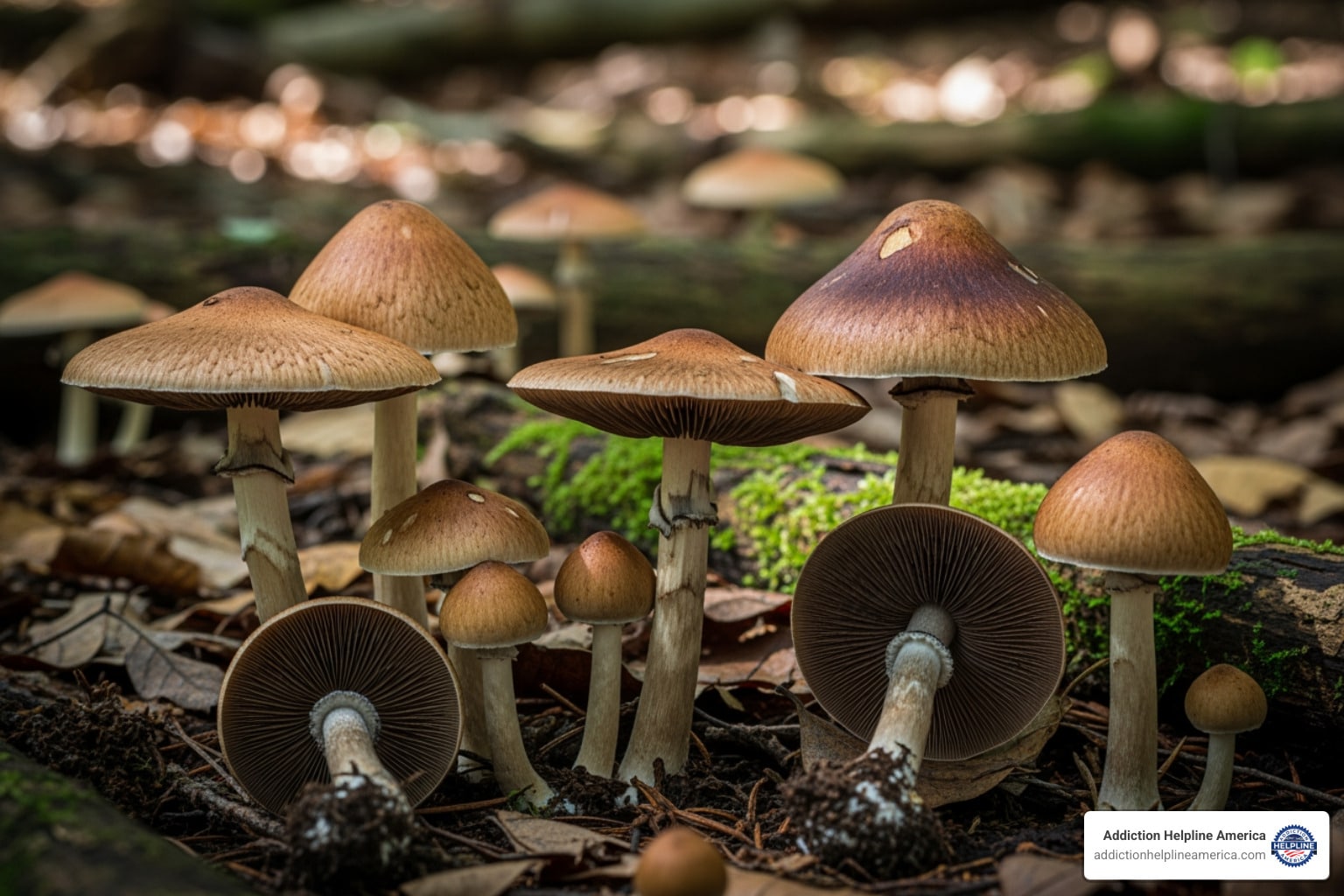
Understanding Psilocybin: A Natural Psychedelic with Complex Effects
Psilocybin is a naturally occurring psychedelic compound found in certain mushroom species, primarily those in the Psilocybe genus. Commonly called “magic mushrooms” or “shrooms,” they produce hallucinogenic effects when consumed. When ingested, your body converts psilocybin into psilocin, which interacts with serotonin receptors in your brain, leading to altered perception, mood changes, and hallucinations.
Quick Facts About Psilocybin:
- What it is: A psychedelic chemical found in over 200 species of mushrooms
- How it works: Converts to psilocin in the body, binds to brain serotonin receptors
- Effects: Hallucinations, altered sense of time, mood changes, physical symptoms like nausea
- Duration: Effects typically last 4-6 hours after a 30-minute onset
- Legal status: Schedule I controlled substance under federal law (illegal in the US)
- Safety: Low addiction potential but carries risks of “bad trips,” psychological distress, and accidental poisoning from misidentified mushrooms
Psilocybin use dates back thousands of years in indigenous spiritual and healing ceremonies. Today, interest has surged, with the National Survey on Drug Use and Health reporting that 8.8 million Americans ages 12 and older used hallucinogens, including psilocybin, in 2023. This popularity stems from recreational use and emerging research into its therapeutic potential for depression, anxiety, and addiction.
However, psilocybin remains illegal under federal law and carries significant risks, including psychological distress, dangerous behavior, and the real danger of consuming poisonous look-alike mushrooms.
At Addiction Helpline America, we support individuals and families with questions about substances like psilocybin. Our mission is to provide clear, science-based information on its effects and risks while connecting those in need with compassionate, confidential treatment resources.
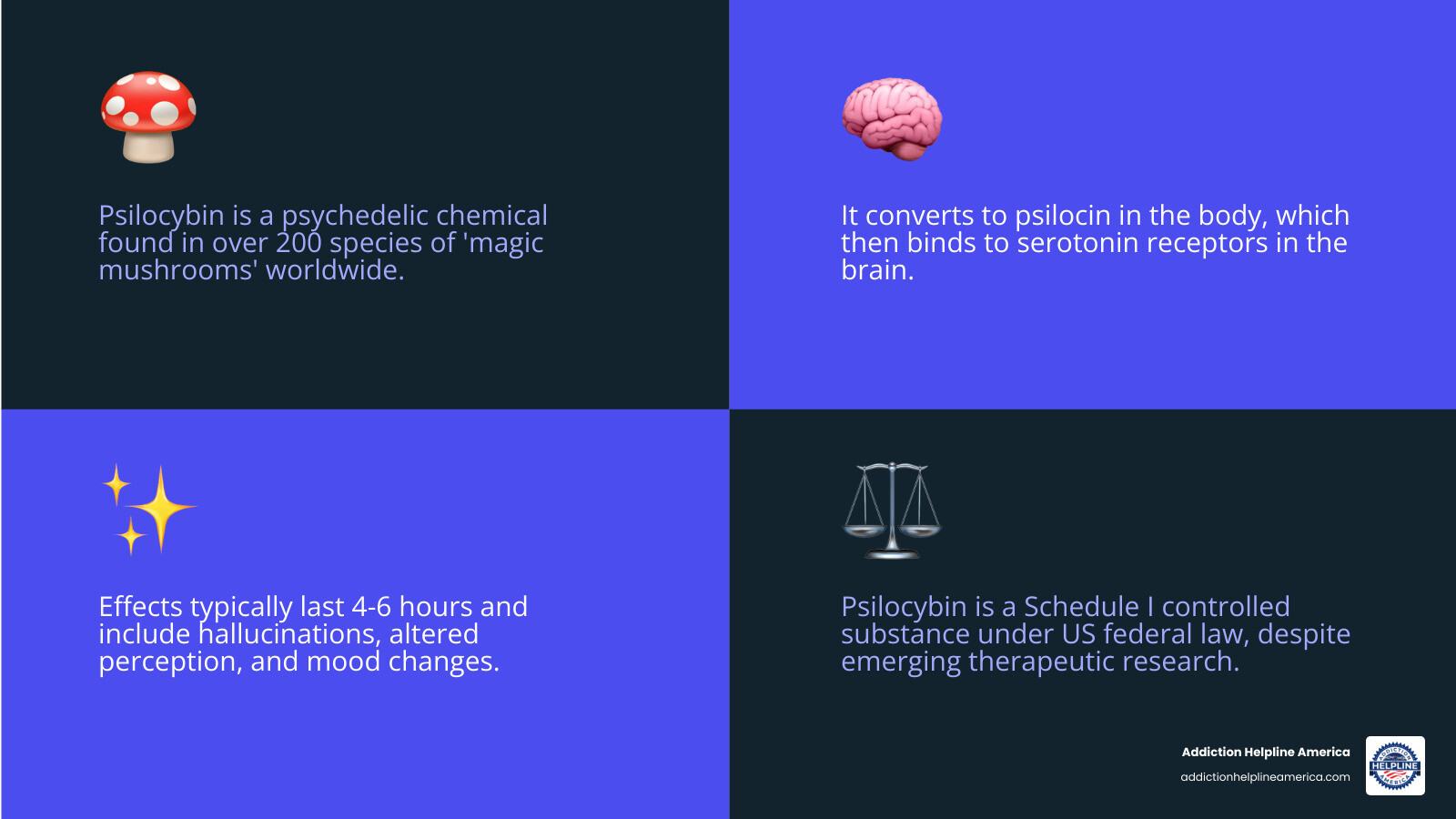
Understanding Psilocybin: From Mushroom to Mind
Psilocybin is a naturally occurring chemical compound that falls into the psychedelic drug class. Think of it as nature’s way of creating a mind-altering experience—though one that requires caution and respect.
The primary natural source of psilocybin is mushrooms from the Psilocybe genus. These aren’t your typical grocery store button mushrooms. They grow wild in various regions around the world, with particularly notable populations in Mexico, Central America, and throughout the United States. While there are over 200 species that contain psilocybin, they share some common identifying features.
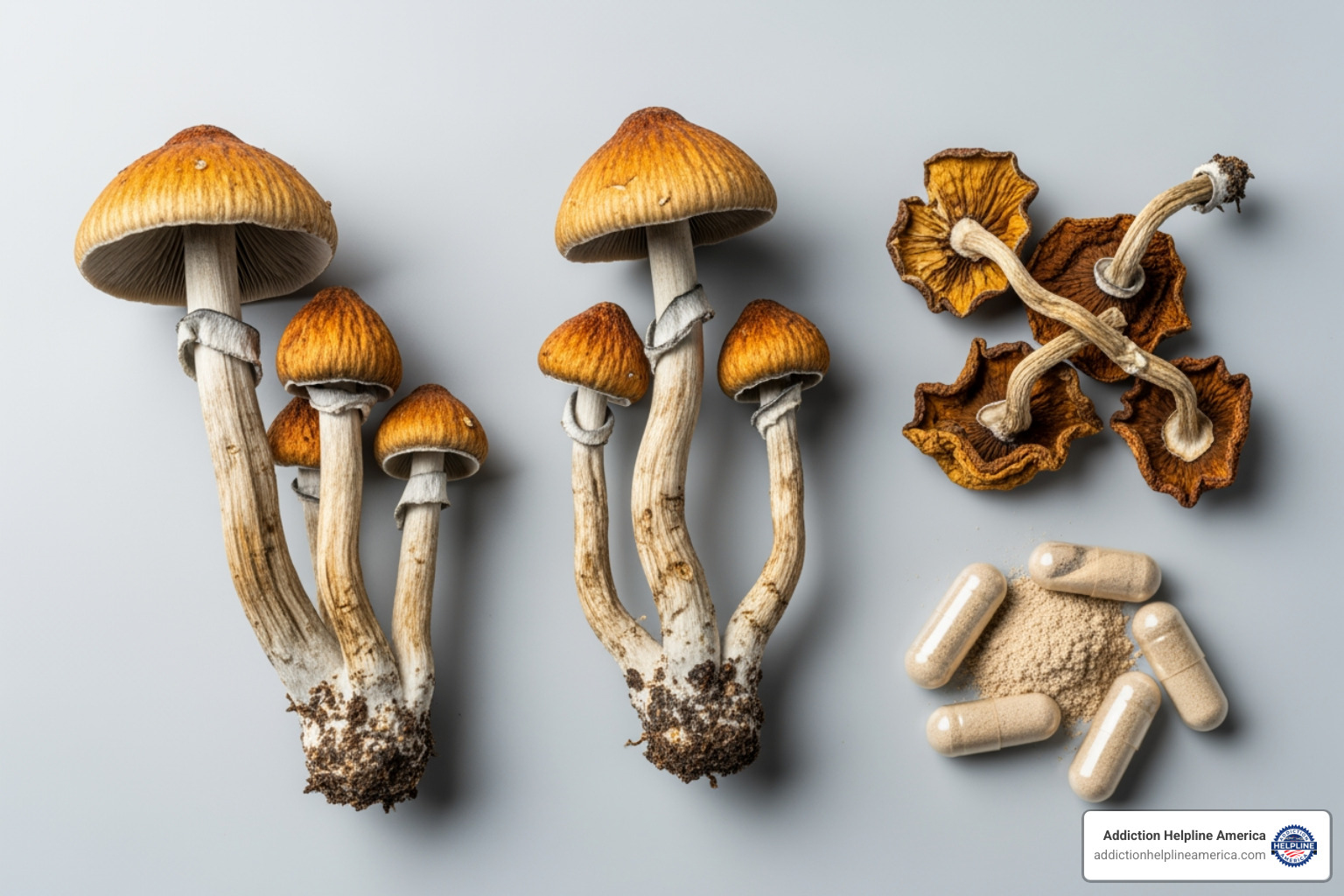
Psilocybin mushrooms are typically fresh or dried with long, slender, whitish stems and brown or tan caps with dark gills underneath. When dried, they become a rusty brown color. Beyond the whole mushroom form, psilocybin also appears in powdered or capsule preparations. Some people crush dried mushrooms into powder, while others brew them as tea or mix them into food to mask the notoriously bitter taste.
On the street, you’ll hear these mushrooms called by various names: Magic Mushrooms, Shrooms, and Mushies are among the most common.
How Psilocybin Works in the Brain
The journey from mushroom to mind-altering experience involves fascinating brain chemistry. When you consume psilocybin, your body quickly converts it into another compound called psilocin—and that’s what creates the effects.
Psilocin interacts with your brain’s serotonin system, a neurotransmitter that helps regulate mood and perception. Psilocin specifically binds to 5-HT2A receptors, specialized docking stations for serotonin, triggering the hallucinogenic experience.
Psilocin primarily affects the prefrontal cortex (governing thought and perception) and the amygdala (the emotional center). By sending unusual signals to these areas, it shifts normal patterns of thought and perception.
Psilocybin also disrupts the default mode network (DMN), a set of brain regions active during self-reflection and daydreaming. At the same time, it increases connectivity between brain regions that don’t normally communicate. This temporary rewiring may explain feelings of ego dissolution, interconnectedness, and novel thinking patterns.
Methods of Consumption and Potency Factors
Most people consume psilocybin through oral ingestion. The simplest method is eating the mushrooms, but since they have an unpleasant, earthy taste, many people get creative. Some prefer brewing them as tea or adding them to food like chocolate. You might also find psilocybin in capsule form, which offers a more precise way to measure a dose.
Dosage is typically measured in grams for dried mushrooms or milligrams for pure psilocybin extract. However, predicting the exact strength is tricky because not all mushrooms are created equal.
The mushroom species and growing conditions (temperature, light, substrate) significantly affect potency. Some varieties are much stronger than others, and ideal conditions can double a mushroom’s strength.
Potency also depends on whether mushrooms are fresh versus dried. Dried mushrooms are more concentrated by weight. Potency degrades over time, especially with exposure to heat, light, or moisture, making proper storage (cool, dark, airtight) crucial.
All these variables mean that predicting the exact strength of any given dose can be challenging—one of many reasons psilocybin use carries inherent risks.
The Psychological and Physical Effects of a Psilocybin Trip
Once you take psilocybin, the experience unfolds in a predictable timeline, though the intensity varies. The hallucinogenic effects typically begin within 30 minutes of ingestion, building to a peak that lasts between four and six hours. For some, subtle perceptual changes can linger even longer.
Understanding what to expect during these hours is essential, whether you’re considering psilocybin yourself or supporting someone who has used it.

Common Psychological Effects
The psychological journey defines a psilocybin experience. These effects can be profound, enlightening, or deeply unsettling.
Altered perception is central to the experience. Users often report vivid visual hallucinations, such as seeing geometric patterns, impossibly bright colors, or moving objects. Sounds can become distorted, and some experience synesthesia, where senses blend (e.g., “seeing” music).
Time perception becomes distorted, with minutes feeling like hours or vice versa. Your sense of reality becomes fluid, blurring the line between internal thoughts and the external world, which can be disorienting.
Emotions become amplified and unpredictable. Some people experience intense euphoria, spiritual connection, or profound insights, while others face anxiety, paranoia, and overwhelming fear, especially if the experience is too intense.
During the peak, distinguishing fantasy from reality becomes genuinely challenging. This is one reason why psilocybin trips can turn frightening for unprepared users.
Physical Effects on the Body
While the focus is often on the mind-altering aspects, psilocybin also creates tangible physical sensations.
Nausea and stomach discomfort are common, especially during the first hour. Some people vomit, which is why many prefer brewing psilocybin as tea. Muscle weakness and poor coordination are also common.
Visible physical signs include dilated pupils, increased heart rate and blood pressure, and liftd body temperature, which can cause flushing. Some also experience rapid breathing.
These physical changes aren’t usually dangerous for healthy individuals, but they’re important to recognize.
Factors Influencing the Experience
No two psilocybin trips are alike. The experience depends heavily on “set and setting“—your mindset and the environment.
Your mental state before taking psilocybin is critical. Anxiety or fear can be amplified, while an open and curious mindset may lead to a more positive experience. Your personality and expectations also color the journey.
The physical environment is equally crucial. A safe, comfortable space with trusted people is ideal. Chaotic or unfamiliar surroundings can trigger anxiety and increase the chances of a difficult trip.
Dosage directly impacts intensity. Higher doses don’t just make effects stronger—they increase the risk of overwhelming, negative experiences.
Finally, having a trusted guide or sober sitter present can make an enormous difference. A sober sitter offers reassurance and helps ensure safety. In therapeutic settings, trained guides help patients steer difficult emotions toward meaningful insights.
Risks, Safety Concerns, and Potential for Abuse of Psilocybin
Understanding psilocybin means looking at both its potential and its very real dangers. At Addiction Helpline America, we want you to know what you’re dealing with before you or someone you care about considers psilocybin use.

The most immediate risk is a “bad trip,” a terrifying experience of intense fear, paranoia, or psychosis-like episodes where one loses touch with reality. The risk of these negative experiences increases with higher doses of psilocybin and pre-existing anxiety.
Psychological risks can persist. Some develop Hallucinogen-Persisting Perception Disorder (HPPD), involving unsettling flashbacks. The National Institute on Drug Abuse notes these perceptual distortions can occur weeks or even years later. For anyone with a history of psychosis or schizophrenia, psilocybin can trigger or worsen symptoms, potentially requiring emergency care.
Physical Health Risks and Overdose Potential
While psilocybin itself rarely causes fatal physical harm, the surrounding dangers are very real.
The biggest physical danger is mushroom misidentification. Psilocybin mushrooms look similar to poisonous varieties, and the DEA reports that users risk accidental poisoning from eating a toxic mushroom by mistake. Some toxic mushrooms can cause liver failure, kidney failure, or death. To prevent accidental consumption by children, you should regularly remove all mushrooms from areas where children are present.
The unregulated market is also dangerous. Products sold as psilocybin, like chocolates, may be mislabeled or contaminated with toxic chemicals, causing severe illness.
While a fatal overdose from psilocybin is extremely rare, taking too much can cause an overwhelmingly intense trip, leading to severe psychological distress, psychosis, and dangerous behavior. The inability to distinguish reality from fantasy can lead to accidental harm or death.
Mixing psilocybin with other drugs creates additional risks. Combining it with antidepressants can potentially trigger serotonin syndrome, a dangerous condition. Using it with stimulants increases cardiovascular risks. Using “trip killers” like benzodiazepines to end a bad trip may pose additional risks and is not well understood.
For pregnant or breastfeeding individuals, the advice is clear: avoid psilocybin entirely due to a lack of safety research.
Potential for Psilocybin Abuse and Dependence
Regarding addiction, psilocybin behaves differently than many other substances. According to the National Institute on Drug Abuse, psilocybin is not considered addictive, and no physical withdrawal symptoms occur after stopping use.
Tolerance to psilocybin develops rapidly with frequent use, requiring higher doses for the same effect, but it also fades quickly after stopping.
While physical addiction isn’t a concern, psychological patterns can still develop. Some people experience difficulty adjusting to reality after heavy use. The DSM-5 includes psilocybin under “Other Hallucinogen Use Disorder,” recognizing that problematic use can emerge. Constantly thinking about the next trip or using it to escape daily problems are signs of an unhealthy relationship with the substance. In these situations, reaching out for support is crucial.
The Evolving Landscape: Therapeutic Research and Legal Status
Indigenous Mesoamerican cultures have used psilocybin mushrooms in spiritual rituals for centuries. The compound entered Western science in 1958 when Swiss chemist Albert Hofmann isolated and synthesized it.
Despite this history, the legal landscape shifted during the “War on Drugs.” Today, psilocybin is classified as a Schedule I substance under the Controlled Substances Act. This federal designation places it in the most restrictive category, meaning it has a high potential for abuse, no accepted medical use, and lacks safety standards for medical supervision, according to the DEA. This status makes psilocybin illegal to manufacture, possess, or distribute under federal law.
Yet, a shift is occurring at state and local levels. Cities like Denver, Oakland, and Washington D.C. have decriminalized psilocybin. More significantly, Oregon (2020) and Colorado (2022) legalized regulated psilocybin therapy. This creates a complex patchwork of laws, with a tension between federal classification and mounting research on therapeutic potential. As more states explore reform, this debate continues to evolve.
Therapeutic Potential for Mental Health Conditions
Despite federal restrictions, scientists are conducting rigorous studies on psilocybin‘s therapeutic applications with exciting results.
Depression is a promising area of research. A 2024 review on antidepressant effects suggests psilocybin may produce lasting relief, even for patients with treatment-resistant symptoms. The mechanism may involve regulating the brain’s reward system. The evidence is compelling enough that the FDA granted Breakthrough Therapy designation to certain psilocybin formulations for treatment-resistant depression, recognizing its potential to significantly improve on existing therapies.
Psilocybin has also shown remarkable promise for anxiety and end-of-life distress, especially in cancer patients. Studies show a single guided session can produce lasting reductions in anxiety and depression, with patients reporting profound shifts in perspective and improved quality of life.
Research into substance use disorders is also encouraging. Early studies suggest psilocybin may help people break alcohol and tobacco addiction. The National Institute on Drug Abuse is funding a large study comparing psilocybin-assisted therapy to a nicotine patch for smoking cessation.
Crucially, these benefits occur within psilocybin-assisted psychotherapy. This structured process involves preparation, supervised administration in a clinical setting, and integration sessions with a therapist. The supportive context is as essential as the compound itself.
The Practice of Microdosing Psilocybin
You may have heard about microdosing—taking very small, sub-perceptual doses of psilocybin (about one-tenth of a recreational dose) every few days.
Advocates claim benefits like improved mood, creativity, and focus. The appeal is getting psilocybin‘s potential benefits without the intense trip.
However, despite anecdotal reports, current research lacks conclusive evidence to prove these benefits. Studies suggest many positive effects may be due to the placebo effect, raising questions about what causes the improvements.
The long-term effects of regular microdosing remain unknown. Without established guidelines or medical oversight, people who microdose are essentially conducting unsupervised experiments on themselves.
At Addiction Helpline America, we believe in informed choices. If you’re considering psilocybin, we encourage you to understand both the potential and the risks, and to seek professional guidance when possible.
Frequently Asked Questions about Psilocybin
Throughout our years at Addiction Helpline America, we’ve heard countless questions about psilocybin. Here are some of the most common ones, answered with clarity and compassion.
What drugs have similar effects to psilocybin?
Psilocybin belongs to the classic psychedelic or hallucinogen category. Its effects are similar to LSD (Lysergic Acid Diethylamide) and Mescaline, the active compound in the peyote cactus. Both produce powerful hallucinogenic effects and have long histories of use.
These substances share a mechanism—acting on serotonin 5-HT2A receptors—which causes similar effects. This also leads to cross-tolerance, meaning frequent use of one can reduce the effects of another.
Can you stop a “bad trip” once it has started?
This is an urgent question we often receive. The honest answer is there’s no “off switch” for a psilocybin trip; it must run its course, typically lasting four to six hours.
However, harm reduction techniques can ease a challenging experience. These include changing the setting to a quieter space, playing calming music, and having reassurance from a sober, trusted sitter who can remind the person that the experience is temporary and they are safe.
You may have heard of “trip killers” like benzodiazepines (Xanax) or antipsychotics. However, this practice carries additional risks, and the research is limited. We strongly advise against mixing substances without professional medical guidance, as interactions can be unpredictable and dangerous.
How likely is accidental poisoning from psilocybin mushrooms?
This is a critical safety concern. The risk of accidental poisoning is significant for anyone who forages for mushrooms in the wild. Many poisonous species look remarkably similar to psilocybin-containing mushrooms, and misidentification can be severe.
Symptoms of mushroom poisoning range from gastrointestinal distress (nausea, vomiting) to severe outcomes like liver or kidney failure, neurological damage, or even death. While most cases are minor, severe poisoning requires emergency medical attention.
Our safety advice is absolute: never consume wild mushrooms unless positively identified by an expert mycologist. The stakes are too high. The European Monitoring Centre for Drugs and Drug Addiction also recommends regularly removing all mushrooms from areas where children play to prevent accidental consumption.
Conclusion: Navigating the Complexities of Psilocybin
Psilocybin is a powerful psychedelic compound with a complex story, presenting both promise and significant risk.
On one hand, research shows promise for its use in controlled therapeutic settings to treat depression, anxiety, and addiction, a potential recognized by the FDA’s Breakthrough Therapy designation. On the other hand, significant risks exist, including terrifying “bad trips,” long-term psychological impacts like Hallucinogen-Persisting Perception Disorder (HPPD), and the fatal danger of accidental poisoning from misidentified mushrooms.
The legal landscape is also complex. Psilocybin is a federally illegal Schedule I substance, yet states like Oregon and Colorado are creating regulated access, resulting in a confusing patchwork of laws.
It’s clear that context is critical. The “set and setting” (mindset and environment) can determine if an experience is transformative or traumatic. Medical supervision, proper dosing, and psychological support are key to navigating its use safely.
At Addiction Helpline America, we believe in the power of informed choices. Whether you’re curious about psilocybin, concerned about someone’s use, or dealing with substance use or mental health challenges, having accurate information is the first step. But information alone isn’t always enough.
If you or someone you care about is struggling with substance use or mental health concerns, please know that help is available and you don’t have to figure this out alone. We offer free, confidential support to connect you with treatment options that fit your unique situation. Our network spans all 50 states and the District of Columbia, and we’re here to provide personalized guidance without judgment. Find personalized guidance for treatment options that can help you steer these complexities and find a path forward toward healing and recovery.
Your well-being matters, and reaching out for help is a sign of strength, not weakness. We’re here whenever you’re ready.
Our helpline is 100%
free & confidential
If you or someone you care about is struggling with drug or alcohol addiction, we can help you explore your recovery options. Don’t face this challenge alone—seek support from us.
Programs
Resources
Will my insurance
cover addiction
treatment?
We're ready to help
Find the best
drug or alcohol treatment
center
Are you or a loved one struggling with addiction? Call today to speak to a treatment expert.

